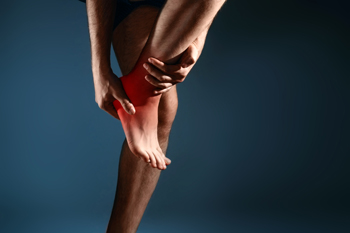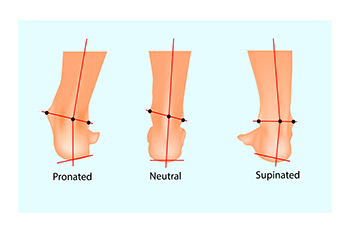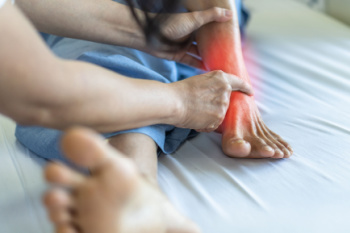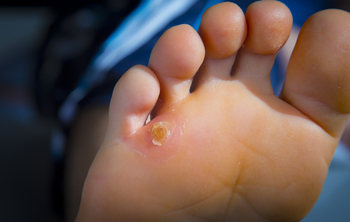Connect With Us
Blog
Items filtered by date: April 2024
Facts About Posterior Heel Pain

Posterior heel pain can be caused by various conditions that can significantly impact daily life. Achilles tendinopathy, often induced by excessive mechanical loading or certain medications, results in achy or sharp pain that worsens with activity or pressure. Diagnosis of posterior heel pain involves clinical examination by a podiatrist, revealing tenderness along the tendon and sometimes visible thickening. Treatment strategies, including activity modification and specialized exercises, necessitate personalized guidance from a podiatrist. Similarly, Haglund deformity, marked by a prominence at the back of the heel, can lead to retrocalcaneal bursitis. It may require tailored interventions, such as footwear adjustments, certain medications, and in severe cases, surgery. In children between eight and 14 years old who are active in sports, pain in the heel may indicate the onset of Sever’s disease. Ceasing the activity and changing to more supportive footwear, can help. Consulting a podiatrist is essential for accurate diagnosis and effective management of posterior heel pain, as these foot doctors possess the expertise to develop a comprehensive treatment plan tailored to your needs. To regain mobility and ensure that heel pain does not impede daily activities, it is suggested that you schedule an appointment with a podiatrist.
Many people suffer from bouts of heel pain. For more information, contact Alice Kim, DPM of 101 Foot and Ankle. Our doctor can provide the care you need to keep you pain-free and on your feet.
Causes of Heel Pain
Heel pain is often associated with plantar fasciitis. The plantar fascia is a band of tissues that extends along the bottom of the foot. A rip or tear in this ligament can cause inflammation of the tissue.
Achilles tendonitis is another cause of heel pain. Inflammation of the Achilles tendon will cause pain from fractures and muscle tearing. Lack of flexibility is also another symptom.
Heel spurs are another cause of pain. When the tissues of the plantar fascia undergo a great deal of stress, it can lead to ligament separation from the heel bone, causing heel spurs.
Why Might Heel Pain Occur?
- Wearing ill-fitting shoes
- Wearing non-supportive shoes
- Weight change
- Excessive running
Treatments
Heel pain should be treated as soon as possible for immediate results. Keeping your feet in a stress-free environment will help. If you suffer from Achilles tendonitis or plantar fasciitis, applying ice will reduce the swelling. Stretching before an exercise like running will help the muscles. Using all these tips will help make heel pain a condition of the past.
If you have any questions please contact our office located in Camarillo, CA . We offer the newest diagnostic and treatment technologies for all your foot and ankle needs.
Causes and Treatment of Supination

Understanding supination, also called underpronation, is essential for maintaining foot health. Supination occurs when your weight rolls onto the outer edges of the feet during movement. It is often the result of inherited structural issues or muscle weakness. Unfortunately, excessive supination can lead to various problems, including back and hip pain, knee stress, ankle injuries, and plantar fasciitis. Supination can also cause tension in different parts of the body over time, increasing the risk of injuries. Seeking medical help from a podiatrist for a gait analysis is advisable if you suspect supination, or are experiencing unexplained lower body pain. Treatment typically involves corrective measures to address foot alignment and prevent future injuries. This may include selecting appropriate footwear with extra cushioning and room in the toes, using custom-made orthotic insoles, and performing strength and stretching exercises as suggested by a podiatrist. Proper care and intervention can alleviate discomfort and prevent complications associated with supination, ensuring optimal mobility and well-being. If you believe you have pain that results from supination, it is suggested that you schedule an appointment with a podiatrist.
If you have any concerns about your feet, contact Alice Kim, DPM from 101 Foot and Ankle. Our doctor can provide the care you need to keep you pain-free and on your feet.
Biomechanics in Podiatry
Podiatric biomechanics is a particular sector of specialty podiatry with licensed practitioners who are trained to diagnose and treat conditions affecting the foot, ankle and lower leg. Biomechanics deals with the forces that act against the body, causing an interference with the biological structures. It focuses on the movement of the ankle, the foot and the forces that interact with them.
A History of Biomechanics
- Biomechanics dates back to the BC era in Egypt where evidence of professional foot care has been recorded.
- In 1974, biomechanics gained a higher profile from the studies of Merton Root, who claimed that by changing or controlling the forces between the ankle and the foot, corrections or conditions could be implemented to gain strength and coordination in the area.
Modern technological improvements are based on past theories and therapeutic processes that provide a better understanding of podiatric concepts for biomechanics. Computers can provide accurate information about the forces and patterns of the feet and lower legs.
Understanding biomechanics of the feet can help improve and eliminate pain, stopping further stress to the foot.
If you have any questions please feel free to contact our office located in Camarillo, CA . We offer the newest diagnostic and treatment technologies for all your foot and ankle needs.
Ankle Fracture? Don’t Wait for Treatment
Symptoms of Tarsal Tunnel Syndrome
 Tarsal tunnel syndrome is a condition that occurs when the tibial nerve, which runs through the inside of the ankle, becomes compressed. This compression can lead to a range of symptoms, commonly including a tingling sensation, numbness, or a burning pain in the foot, especially in the sole or arch. Some people may also experience these sensations extending to the heel, toes, or up into the calf. The discomfort often worsens with activity and can become more pronounced at night. Tarsal tunnel syndrome can be caused by anything that increases pressure in the tarsal tunnel, such as swelling from an injury, flat feet that strain the nerve, or growths like cysts. If you suspect tarsal tunnel syndrome, it is suggested that you seek prompt evaluation from a podiatrist.
Tarsal tunnel syndrome is a condition that occurs when the tibial nerve, which runs through the inside of the ankle, becomes compressed. This compression can lead to a range of symptoms, commonly including a tingling sensation, numbness, or a burning pain in the foot, especially in the sole or arch. Some people may also experience these sensations extending to the heel, toes, or up into the calf. The discomfort often worsens with activity and can become more pronounced at night. Tarsal tunnel syndrome can be caused by anything that increases pressure in the tarsal tunnel, such as swelling from an injury, flat feet that strain the nerve, or growths like cysts. If you suspect tarsal tunnel syndrome, it is suggested that you seek prompt evaluation from a podiatrist.
Tarsal tunnel syndrome can be very uncomfortable to live with. If you are experiencing tarsal tunnel syndrome, contact Alice Kim, DPM of 101 Foot and Ankle. Our doctor can provide the care you need to keep you pain-free and on your feet.
Tarsal Tunnel Syndrome
Tarsal tunnel syndrome, which can also be called tibial nerve dysfunction, is an uncommon condition of misfiring peripheral nerves in the foot. The tibial nerve is the peripheral nerve in the leg responsible for sensation and movement of the foot and calf muscles. In tarsal tunnel syndrome, the tibial nerve is damaged, causing problems with movement and feeling in the foot of the affected leg.
Common Cause of Tarsal Tunnel Syndrome
- Involves pressure or an injury, direct pressure on the tibial nerve for an extended period of time, sometimes caused by other body structures close by or near the knee.
- Diseases that damage nerves, including diabetes, may cause tarsal tunnel syndrome.
- At times, tarsal tunnel syndrome can appear without an obvious cause in some cases.
The Effects of Tarsal Tunnel Syndrome
- Different sensations, an afflicted person may experience pain, tingling, burning or other unusual sensations in the foot of the affected leg.
- The foot muscles, toes and ankle become weaker, and curling your toes or flexing your foot can become difficult.
- If condition worsens, infections and ulcers may develop on the foot that is experiencing the syndrome.
A physical exam of the leg can help identify the presence of tarsal tunnel syndrome. Medical tests, such as a nerve biopsy, are also used to diagnose the condition. Patients may receive physical therapy and prescriptive medication. In extreme cases, some may require surgery.
If you have any questions please feel free to contact our office located in Camarillo, CA . We offer the newest diagnostic and treatment technologies for all your foot and ankle needs.
How Shoes Affect the Feet

First and foremost, wearing ill-fitting shoes can lead to a myriad of injuries. Whether they are too tight, too loose, or simply not designed for the activity you are engaging in, improper footwear can place undue stress on your feet, ankles, lower legs, and joints, increasing your risk of pain and injury. From common issues like shin splints and ingrown nails to more severe problems such as bunions and postural misalignments, the repercussions of wearing the wrong shoes can be far-reaching and debilitating, potentially limiting your ability to engage in physical activity altogether. Furthermore, wearing the wrong shoes can worsen existing conditions, such as arthritis, making daily activities more challenging and uncomfortable. Plus, when your shoes fail to support your natural gait or foot structure, it can lead to overpronation, underpronation, or other biomechanical issues, placing added strain on your joints and increasing your risk of injury. If your feet are painful after performing certain activities or from wearing certain shoes, it is suggested that you schedule an appointment with a podiatrist to determine whether your footwear may need to be changed.
It is important to find shoes that fit you properly in order to avoid a variety of different foot problems. For more information about treatment, contact Alice Kim, DPM from 101 Foot and Ankle. Our doctor will treat your foot and ankle needs.
Proper Shoe Fitting
Shoes have many different functions. They cushion our body weight, protect our feet, and allow us to safely play sports. You should always make sure that the shoes you wear fit you properly in order to avoid injuries and deformities such as: bunions, corns, calluses, hammertoes, plantar fasciitis, stress fractures, and more. It is important to note that although a certain pair of shoes might be a great fit for someone else, that doesn’t mean they will be a great fit for you. This is why you should always try on shoes before buying them to make sure they are worth the investment. Typically, shoes need to be replaced ever six months to one year of regular use.
Tips for Proper Shoe Fitting
- Select a shoe that is shaped like your foot
- Don’t buy shoes that fit too tight, expecting them to stretch to fit
- Make sure there is enough space (3/8” to ½”) for your longest toe at the end of each shoe when you are standing up
- Walk in the shoes to make sure they fit and feel right
- Don’t select shoes by the size marked inside the shoe, but by how the shoe fits your foot
The shoes you buy should always feel as good as they look. Shoes that fit properly will last longer, feel better, and improve your way of life each day.
If you have any questions, please feel free to contact our office located in Camarillo, CA . We offer the newest diagnostic and treatment technologies for all your foot care needs.
Safe Removal of Corns on the Feet

When dealing with corns on the feet, it is important to prioritize safe removal techniques, particularly if you have underlying health conditions, like diabetes. Seeking professional help from a podiatrist is essential, especially if the corns are painful or if there are concerns about infection or other complications. A podiatrist may use various methods for safe corn removal, including trimming them with a small knife or applying salicylic acid patches to soften them. These procedures are performed in a controlled medical setting to minimize the risk of infection. Additionally, the podiatrist may address underlying structural issues that can contribute to corn formation, such as bunions or hammer toes. It is important to refrain from attempting corn removal yourself, especially for individuals with diabetes or circulation problems. If you have a problem with a corn on the foot, it is suggested that you schedule an appointment with a podiatrist for its safe removal.
If you have any concerns regarding your feet and ankles, contact Alice Kim, DPM of 101 Foot and Ankle. Our doctor will treat your foot and ankle needs.
Corns: What Are They? and How Do You Get Rid of Them?
Corns can be described as areas of the skin that have thickened to the point of becoming painful or irritating. They are often layers and layers of the skin that have become dry and rough, and are normally smaller than calluses.
Ways to Prevent Corns
There are many ways to get rid of painful corns such as wearing:
- Well-fitting socks
- Comfortable shoes that are not tight around your foot
- Shoes that offer support
Treating Corns
Treatment of corns involves removing the dead skin that has built up in the specific area of the foot. Consult with Our doctor to determine the best treatment option for your case of corns.
If you have any questions please feel free to contact our office located in Camarillo, CA . We offer the newest diagnostic and treatment technologies for all your foot and ankle needs.

